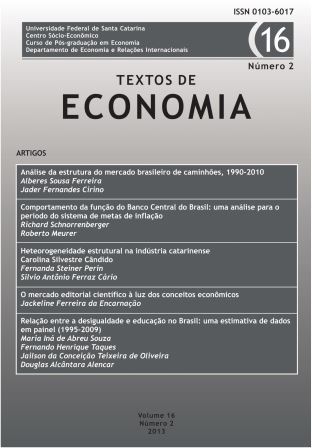Behavior of the Brazilian Central Bank reaction function: an analysis for the inflation targeting period
DOI:
https://doi.org/10.5007/2175-8085.2013v16n2p33Abstract
: The reaction function of the Central bank expresses the preferences of the monetary authority with respect of deviations of his inflation target and the output gap. This paper evaluates the Brazilian Central Bank’s preferences and its changes during the inflation targeting period. The model of Clarida, Galí and Gertler (1999) is employed in a forward looking version. Time series econometrics is the statistical tool. Results show that the preferences of the Brazilian Central Bank are asymmetrical with respect to its goals. The monetary policymaker is more sensitive to price stability, but also takes output in account and smooth´s the interest rate over time. The monetary authority reacted stronger to controlled prices while Armínio Fraga and Henrique Meirelles were incumbent and to free prices during the Alexandre Tombini period. During financial instability periods the weight of price stability grows. There are signs that monetary policy power is increasing during the inflation targeting period, as also finds the Brazilian Central Bank.
Downloads
Published
Issue
Section
License
Os Direitos Autorais para artigos publicados neste periódico são do autor. Em virtude de aparecerem nesta revista de acesso público, os artigos são de uso gratuito, com atribuições próprias, em aplicações educacionais, de exercício profissional e para gestão pública. A Revista adotou a licença Creative Commons - Atribuição-NãoComercial-SemDerivações 4.0 Internacional. Esta licença permite acessar, baixar (download), compartilhar o conteúdo dos artigos desde que citada a fonte, atribuindo os devidos créditos de autoria.

Esta obra está licenciada sob uma Licença Creative Commons - Atribuição-NãoComercial-SemDerivações 4.0 Internacional.



